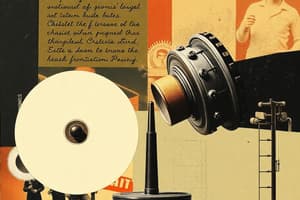Podcast
Questions and Answers
Which of the following activities does NOT primarily demonstrate the turning effect of a force (moment)?
Which of the following activities does NOT primarily demonstrate the turning effect of a force (moment)?
- Opening a door
- Lifting a weight directly upwards with a crane (correct)
- Cutting paper with scissors
- Tightening a bolt with a spanner
The moment of a force is determined only by the magnitude of the force applied and is independent of the distance from the pivot.
The moment of a force is determined only by the magnitude of the force applied and is independent of the distance from the pivot.
False (B)
A seesaw is balanced. If a heavier child sits closer to the pivot, how does this affect the moment on their side, and what must happen on the other side to maintain balance?
A seesaw is balanced. If a heavier child sits closer to the pivot, how does this affect the moment on their side, and what must happen on the other side to maintain balance?
The moment increases due to increased weight, requiring either a lighter child or one sitting closer to the pivot on the other side to balance the moments.
The turning effect of a force is known as its _______, which is calculated by multiplying the force by the perpendicular distance from the pivot.
The turning effect of a force is known as its _______, which is calculated by multiplying the force by the perpendicular distance from the pivot.
Match the following scenarios with the type of rotation they primarily involve:
Match the following scenarios with the type of rotation they primarily involve:
What is the significance of the point where lines cross when determining the center of gravity of a plane lamina?
What is the significance of the point where lines cross when determining the center of gravity of a plane lamina?
Punching holes in the plane lamina after determining the action line of the weight force is a recommended method to improve accuracy.
Punching holes in the plane lamina after determining the action line of the weight force is a recommended method to improve accuracy.
Explain why it is essential to allow the plane lamina to settle before marking the action line of the weight force?
Explain why it is essential to allow the plane lamina to settle before marking the action line of the weight force?
To avoid a parallax error when using a plumb line, it should be viewed straight ______.
To avoid a parallax error when using a plumb line, it should be viewed straight ______.
Match the following actions with their corresponding effect on the experiment's accuracy.
Match the following actions with their corresponding effect on the experiment's accuracy.
What is the first step in solving a moments problem?
What is the first step in solving a moments problem?
In the principle of moments equation, the total clockwise moments are always equal to the total anticlockwise moments.
In the principle of moments equation, the total clockwise moments are always equal to the total anticlockwise moments.
What must be ensured regarding units before applying the principle of moments calculation?
What must be ensured regarding units before applying the principle of moments calculation?
The principle of moments is used to determine the magnitude of the ______ required to balance an object around a pivot.
The principle of moments is used to determine the magnitude of the ______ required to balance an object around a pivot.
Match the following quantities with their correct descriptions in the context of moments:
Match the following quantities with their correct descriptions in the context of moments:
A mechanic uses a spanner to tighten a bolt. A force of 50 N is applied at a distance of 0.2 m from the center of the bolt. What is the moment applied to the bolt?
A mechanic uses a spanner to tighten a bolt. A force of 50 N is applied at a distance of 0.2 m from the center of the bolt. What is the moment applied to the bolt?
According to the principle of moments, for an object to be balanced, the sum of the clockwise moments must be greater than the sum of the anticlockwise moments about a pivot.
According to the principle of moments, for an object to be balanced, the sum of the clockwise moments must be greater than the sum of the anticlockwise moments about a pivot.
State the principle of moments.
State the principle of moments.
Moment is calculated by multiplying force by the ______ distance from the pivot.
Moment is calculated by multiplying force by the ______ distance from the pivot.
Which of the following is the correct unit for measuring the moment of a force?
Which of the following is the correct unit for measuring the moment of a force?
A seesaw is balanced with two children sitting on it. Child A exerts an anticlockwise moment of 60 Nm. What is the clockwise moment exerted by Child B for the seesaw to remain balanced?
A seesaw is balanced with two children sitting on it. Child A exerts an anticlockwise moment of 60 Nm. What is the clockwise moment exerted by Child B for the seesaw to remain balanced?
A force of 30 N is applied to a wrench at a distance of 0.25 m from the bolt. Calculate the moment produced.
A force of 30 N is applied to a wrench at a distance of 0.25 m from the bolt. Calculate the moment produced.
If a force is applied directly at the pivot point, it will create a moment.
If a force is applied directly at the pivot point, it will create a moment.
What is the primary purpose of using a plumb line in the experiment to find the center of gravity of a plane lamina?
What is the primary purpose of using a plumb line in the experiment to find the center of gravity of a plane lamina?
The shape of the plane lamina is the independent variable in this experiment.
The shape of the plane lamina is the independent variable in this experiment.
Why is it important to punch holes near the outer edges of the plane lamina when determining its center of gravity?
Why is it important to punch holes near the outer edges of the plane lamina when determining its center of gravity?
The intersection point of the lines drawn on the plane lamina represents its ______.
The intersection point of the lines drawn on the plane lamina represents its ______.
Match the equipment used in the centre of gravity experiment with its purpose:
Match the equipment used in the centre of gravity experiment with its purpose:
In the experiment, what is the purpose of repeating the process of suspending the lamina and drawing lines of action from multiple points?
In the experiment, what is the purpose of repeating the process of suspending the lamina and drawing lines of action from multiple points?
Using only one line of action is sufficient to accurately determine the center of gravity of an irregularly shaped object.
Using only one line of action is sufficient to accurately determine the center of gravity of an irregularly shaped object.
Explain why using a plumb line ensures the line drawn on the lamina accurately represents the line of action of the weight force.
Explain why using a plumb line ensures the line drawn on the lamina accurately represents the line of action of the weight force.
In an experiment to verify the principle of moments, what role does the ruler play?
In an experiment to verify the principle of moments, what role does the ruler play?
Achieving a 'perfectly horizontal' beam ensures that there is a resultant moment in the system.
Achieving a 'perfectly horizontal' beam ensures that there is a resultant moment in the system.
What must be done with the anticlockwise and clockwise moments for a system to be in equilibrium?
What must be done with the anticlockwise and clockwise moments for a system to be in equilibrium?
In the experiment, equilibrium is reached when the beam is balanced and there is no _______ moment.
In the experiment, equilibrium is reached when the beam is balanced and there is no _______ moment.
Why is it crucial to adjust the positions of masses on the beam in the moment experiment?
Why is it crucial to adjust the positions of masses on the beam in the moment experiment?
Converting grams to kilograms and centimeters to meters is not necessary when calculating moments as long as the units are consistent.
Converting grams to kilograms and centimeters to meters is not necessary when calculating moments as long as the units are consistent.
According to the principle of moments, what is the relationship between the clockwise moment ($M_2$) and the force ($F_2$) and the distance ($s_2$) from the pivot?
According to the principle of moments, what is the relationship between the clockwise moment ($M_2$) and the force ($F_2$) and the distance ($s_2$) from the pivot?
Match the terms with their descriptions:
Match the terms with their descriptions:
Flashcards
What is a Moment?
What is a Moment?
The turning effect of a force when it is exerted on an object.
What is a Pivot?
What is a Pivot?
A fixed point around which an object rotates due to an applied force.
Clockwise Rotation
Clockwise Rotation
Rotation in the same direction as the hands of a clock.
Anticlockwise Rotation
Anticlockwise Rotation
Signup and view all the flashcards
Turning effect of force
Turning effect of force
Signup and view all the flashcards
Principle of Moments
Principle of Moments
Signup and view all the flashcards
Clockwise Moments
Clockwise Moments
Signup and view all the flashcards
Anticlockwise Moments
Anticlockwise Moments
Signup and view all the flashcards
Moments: Key steps
Moments: Key steps
Signup and view all the flashcards
Units for moment?
Units for moment?
Signup and view all the flashcards
How to determine clockwise or anticlockwise?
How to determine clockwise or anticlockwise?
Signup and view all the flashcards
Formula for moment
Formula for moment
Signup and view all the flashcards
Beam Balance System
Beam Balance System
Signup and view all the flashcards
Achieving Equilibrium
Achieving Equilibrium
Signup and view all the flashcards
Moment Calculation
Moment Calculation
Signup and view all the flashcards
Pivot Point
Pivot Point
Signup and view all the flashcards
Equilibrium Condition
Equilibrium Condition
Signup and view all the flashcards
Resultant Moment
Resultant Moment
Signup and view all the flashcards
Center of Gravity
Center of Gravity
Signup and view all the flashcards
Plane Lamina
Plane Lamina
Signup and view all the flashcards
Suspension Equilibrium
Suspension Equilibrium
Signup and view all the flashcards
Parallax Error (Plumb Line)
Parallax Error (Plumb Line)
Signup and view all the flashcards
Reducing Random Errors
Reducing Random Errors
Signup and view all the flashcards
Irregular Lamina Purpose
Irregular Lamina Purpose
Signup and view all the flashcards
Hole Punch Use
Hole Punch Use
Signup and view all the flashcards
Thread Purpose
Thread Purpose
Signup and view all the flashcards
Plumb Line Function
Plumb Line Function
Signup and view all the flashcards
Pencil and Ruler Task
Pencil and Ruler Task
Signup and view all the flashcards
Clamp Stand Role
Clamp Stand Role
Signup and view all the flashcards
Suspension Method
Suspension Method
Signup and view all the flashcards
Steps to Find Centre of Gravity
Steps to Find Centre of Gravity
Signup and view all the flashcards
Study Notes
Moments
- The turning effect of a force is called the moment.
- The moment of a force is calculated by multiplying the force by the perpendicular distance from the pivot.
- Forces can cause rotation of an object around a fixed pivot point.
- This rotation can occur either clockwise or anticlockwise.
Moment Equation
- A moment is defined as the turning effect of a force about a pivot.
- The size of the moment is calculated using: moment = force × perpendicular distance from pivot.
- Forces should be perpendicular to the distance from the pivot.
- Increasing the distance from the pivot reduces the amount of force required to achieve the same moment.
- The further from the hinge, the easier it is to open a door, as less force is required.
- Measured in Newton Metres (Nm) .
Principle of Moments
- States that if an object is balanced, the total clockwise moment about a pivot equals the total anticlockwise moment about that pivot.
- For a balanced object, sum of clockwise moments = sum of anticlockwise moments
- In situations where forces and distances of objects on a beam differ but the system is balanced, the principle of moments is applied.
- Clockwise and anticlockwise moments acting on a beam are balanced.
Equilibrium
- In physics, means a state of balance or stability.
- A system keeps doing what it's doing without any change when in equilibrium.
- For objects in equilibrium, the forces must be balanced, there must be no resultant force, clockwise moments must equal the sum of anticlockwise moments and there must be no resultant moment.
- When the forces and moments on an object are balanced, the object will remain in equilibrium.
Investigating Equilibrium
- This experiment aims to demonstrate that there is no resultant moment for an object in equilibrium.
- Independent variables include force (F) and distance (s).
- The dependent variable is moment (M).
- The length of cotton loops should be the same on each side of the beam.
- Equipment needed includes a ruler with a small hole at the center, mass hangers, masses, a clamp stand, optical pin with cork, plasticine and cotton loops.
- Hang unequal loads on either side of the pivot, and adjust the distances of each mass until the beam is balanced and horizontal.
- The mass and distance from the pivot must be recorded and g must be converted to kg while cm must be converted to m to give units of Nm.
- The anticlockwise moment needs to be equal to the clockwise moment when the system is in equilibrium.
- The cotton loops should be added to the ruler when looking straight on to avoid parallax error, and should be measured to ensure they are equal in length.
- Safety goggles should be worn for this experiment, and a G clamp should be used to secure the clamp stand to the bench.
Centre of Gravity
- The centre of gravity of an object is the point through which its weight acts.
- For symmetrical objects of uniform density, the centre of gravity lies at the point of symmetry (e.g. centre of a sphere).
- Is along the axis of symmetry for a symmetrical object.
- The position of the centre of gravity affects an object's stability.
- An object is stable when its centre of gravity lies above its base.
- If the line of action of the weight force lies outside the base of the object, there will be a resultant moment, and the body will topple.
- The most stable objects have a low centre of gravity and a wide base.
- Taller objects with a narrow base have a higher centre of gravity and are less stable.
- The car can be tilted to 60 degrees without toppling however the bus topples at 45 degrees.
Investigating Centre of Gravity
- Aims to determine the position of the centre of gravity of an irregularly shaped plane lamina.
- The independent variable is the position of the centre of gravity.
- The dependent variable is the shape of the plane lamina.
- Holes should be punched in the plane lamina before determining the line of action of the weight force.
- The plane lamina will need to be irregularly shaped, the hole punch will make a hole to tie string on the point of suspension and you'll need string to hang the plane lamina with a clamp.
- Punch holes near the outer edges of the plane lamina in different locations.
- Use a plumb line aligned with the hanging thread to mark a line of the weight force on the plane lamina.
- The plumb line should be viewed straight on to avoid parallax error.
- Dots should be made whilst in position and a ruled line should be made after the plane has been removed from the clamp.
Studying That Suits You
Use AI to generate personalized quizzes and flashcards to suit your learning preferences.




